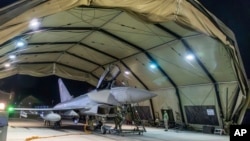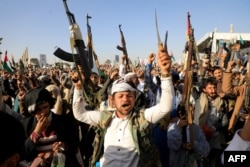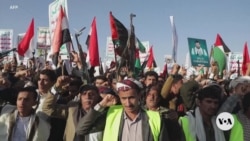The U.S. military carried out an additional strike early Saturday against Houthi positions in Yemen in an effort to protect shipping in the Red Sea, according to U.S. media reports.
News organizations citing anonymous sources said the latest strike targeted a radar site that officials said presented a continuing threat to maritime traffic.
The strike came a little more than a day after the U.S. and British militaries carried out dozens of strikes against Houthi positions in Yemen, in retaliation for weeks of Houthi attacks that have disrupted shipping and damaged vessels transiting the Red Sea and Gulf of Aden.
Houthi militants did launch an anti-ship ballistic missile early Friday, U.S. military officials confirmed, though it did not hit any ships.
U.S. and British officials expressed optimism Friday that the initial strikes late Thursday, which are now being described as two waves of strikes, were successful.
A U.S. defense official told VOA on Friday that the initial assessment indicated the first wave of precision strikes late Thursday degraded the ability of the Houthis to launch further attacks.
The official, speaking on the condition of anonymity in order to discuss operational details, said a more comprehensive assessment of the strikes was still underway. But the sentiment echoed other early assessments by senior U.S. officials, who described the damage to Houthi capabilities as "significant."
"We feel very confident about where our munitions struck," Lieutenant General Douglas Sims, the director of the Joint Staff, told reporters Friday. "But we don't know at this point the complete battle damage assessment."
U.S. Central Command late Thursday said that U.S. fighter jets, naval vessels and submarines hit more than 60 targets at 16 locations across Houthi-controlled parts of Yemen, including command and control nodes, munitions depots, launching systems and production facilities.
But Sims said Friday that the U.S. and Britain launched a second wave of strikes against another 12 locations 30 minutes to an hour after the initial strikes were carried out.
The additional sites, each with multiple targets, "had been identified as possessing articles that could be potentially used against forces, maritime and air," he said, noting the strikes were taken in self-defense.
U.S. officials said, in all, more than 150 precision-guided munitions were aimed at Houthi targets, including Tomahawk Land Attack Missiles.
At least three U.S. guided missile cruisers and destroyers (the USS Gravely, the USS Philippine Sea and the USS Mason) took part in the strikes along with an Ohio-class submarine, fighter jets from the USS Dwight D. Eisenhower aircraft carrier, and U.S. Air Force jets.
A separate statement Friday from the British Defense Ministry said four of its Typhoon fighter jets, accompanied by an air refueling tanker, used laser-guided bombs to hit two locations: a drone launch site in Bani, in northwestern Yemen, and an airfield in Abbs, used to launch cruise missiles and drones at ship in the Red Sea.
"Early indications are that the Houthis' ability to threaten merchant shipping has taken a blow," the ministry said.
Despite the optimistic strike assessments, U.S. officials have said they believe the Houthis are likely to retaliate.
"My guess is that the Houthis are trying to figure things out on the ground and trying to determine what capabilities still exist for them," said Sims. "Their rhetoric has been pretty strong and pretty high, and I would expect that they will attempt some sort of retaliation."
"I would hope they wouldn't," he added, describing the Houthi efforts as "generally fruitless."
But the White House repeated its warning Friday that the Houthis would face additional consequences if their attacks persisted.
“We will make sure that we respond to the Houthis if they continue this outrageous behavior, along with our allies,” President Joe Biden said in response to reporters’ questions during a stop at a coffee shop in Pennsylvania on Friday.
Also Friday, the U.S. unveiled new sanctions aimed at commodity shipments that have been funding the Houthis and their Iranian backers.
U.S. Treasury officials imposed sanctions on a Hong-Kong-based company and another company in the United Arab Emirates, both of which have been working with Sa'id al-Jamal, a financier who has been supporting both the Houthis and Iran's Islamic Revolutionary Guard Corps Quds Force.
"We will take all available measures to stop the destabilizing activities of the Houthis and their threats to global commerce," Treasury Under Secretary Brian Nelson said in a statement.
Since mid-November, the Houthis have launched at least 28 attacks, affecting citizens, cargo and vessels from more than 50 countries, according to the U.S.
U.S. officials have said Biden decided to launch Thursday's strikes following a Houthi attack on shipping lanes in the Red Sea and Gulf of Aden on Tuesday that involved 18 one-way attack drones, two cruise missiles and one ballistic missile.
U.S. combat jets, along with U.S. and British military vessels, responded by shooting down the drones and missiles, averting any damage to ships or injuries to their crews in the area.
Last week, the United States and 12 allies issued a statement warning the Houthis of unspecified consequences if their attacks on shipping in the Red Sea continued.
The statement followed the launch in mid-December of Operation Prosperity Guardian by the United States, Britain and nearly 20 other countries to protect ships from Houthi attacks.
Since the launch of Prosperity Guardian, at least 1,500 vessels have passed safely through the Bab el-Mandeb Strait, which connects the Red Sea with the Gulf of Aden.
The U.N. Security Council issued its own resolution Wednesday, calling on the Houthis to stop the attacks immediately.
But Russia, which abstained in the vote, called for an emergency meeting of the council Friday evening to discuss the strikes. Ambassador Vassily Nebenzia called the U.S.-British strikes a “blatant armed aggression against another country.” He argued that the strikes did not meet the conditions for self-defense under Article 51 of the U.N. Charter.
“Article 51 does not apply to the situation with commercial shipping,” Nebenzia said. “The right to self-defense cannot be exercised in order to ensure the freedom of shipping. Our American colleagues know this fact very well.”
In a statement Friday, U.N. Secretary-General Antonio Guterres said attacks against international shipping in the Red Sea area were “not acceptable,” were endangering the safety and security of global supply chains and had a negative impact on the economic and humanitarian situation worldwide. He urged the Houthis to immediately cease their attacks and called for all parties to respect the Security Council resolution in its entirety.
U.S. Ambassador Linda Thomas-Greenfield told the Council that the strikes were consistent with international law and Article 51. She said Washington does not take such strikes lightly and they were only carried out “after nonmilitary options proved inadequate to address the threat.”
VOA White House Bureau Chief Patsy Widakuswara and U.N. Correspondent Margaret Besheer contributed to this report.















